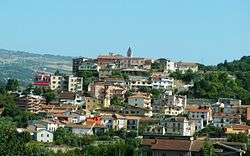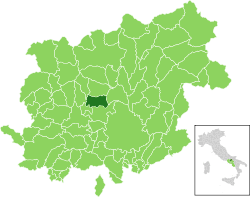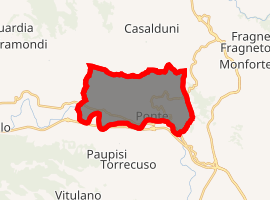Ponte, Campania
Ponte is the name of a town and comune in the Province of Benevento, Campania Region, Italy. It is a member of the Titerno "Local Action Group" (GAL) and its name means bridge in Italian language.
Ponte | |
|---|---|
| Comune di Ponte | |
 | |
 Ponte within the Province of Benevento | |
Location of Ponte 
| |
 Ponte Location of Ponte in Italy  Ponte Ponte (Campania) | |
| Coordinates: 41°13′N 14°42′E | |
| Country | Italy |
| Region | Campania |
| Province | Benevento (BN) |
| Frazioni | Canale, Colli, Ferrarisi, Monte, Piana, Puglia, Staglio |
| Area | |
| • Total | 17.79 km2 (6.87 sq mi) |
| Elevation | 147 m (482 ft) |
| Population (1 May 2009)[2] | |
| • Total | 2,659 |
| • Density | 150/km2 (390/sq mi) |
| Demonym(s) | Pontesi |
| Time zone | UTC+1 (CET) |
| • Summer (DST) | UTC+2 (CEST) |
| Postal code | 82030 |
| Dialing code | 0824 |
| ISTAT code | 062053 |
| Patron saint | San Giovanni Nepomuceno |
| Saint day | 16 May |
| Website | Official website |
Geography
The municipality is located some km in north-west of Benevento and borders with Casalduni, Fragneto Monforte, Paupisi, San Lorenzo Maggiore, San Lupo and Torrecuso. It counts 7 little civil parishes (frazioni): Canale, Colli, Ferrarisi, Monte, Piana, Puglia and Staglio.
History
Ponte has its origins in an ancient Roman stone bridge which was the passage of the Via Latina over the Alento river. The first settlements can be traced back to Roman Empire times, in fact it was here that the roadway Via Latina, connecting Benevento with Rome through the Telesia Valley, passed. The bridge that the passed over the Alento river is today known as the St. Anastasia Bridge. The town was very important even during the Lombard domination. The old town is of medieval origin, although little is left of the castle of Norman origin built in the eleventh century CE. There was also a large Benedictine abbey built in the eighth century AD. The territory was ruled by the Count Ranulf Baldwin Norman, who took care of the development, renewing and expanding the ancient church of Denis which he dedicated to St. Benedict. In later times, Ponte belonged to the major families of the Kingdom, such as the Sanframondos, the Carafas, and the Caracciolos, for example. Ponte was a stronghold of the House of Sanframondo, but during this period, due to a plague and a violent earthquake, which devastated a good part of the area, Ponte became uninhabited. In 1585 it was bought by Domenico Sarri, who retained the title of Duke of Ponte until the abolition of the feudal regime. On June 18, 1913, the city was grant autonomy from the frazione of Casalduni.[3]
Demographics

References
- "Superficie di Comuni Province e Regioni italiane al 9 ottobre 2011". Istat. Retrieved 16 March 2019.
- All demographics and other statistics from the Italian statistical institute (Istat); Dati - Popolazione residente all'1/5/2009
- "Archived copy". Archived from the original on 2011-07-22. Retrieved 2011-03-11.CS1 maint: archived copy as title (link)
External links
![]()
- (in Italian) Ponte official website
- (in Italian) Ponte on "GAL Titerno" website